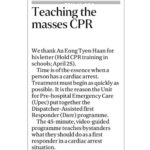Super excited to have my letter about CPR education published in the Straits Times Forum page yesterday https://www.straitstimes.com/forum/letters-in-print/teaching-the-masses-cpr and thought I would break it down and explain what that was all about.
“Time is of the essence when a person has a cardiac arrest.”
What is a cardiac arrest?
It’s difficult to appreciate this statement if you don’t realise what a cardiac arrest is. A cardiac arrest happens when the heart suddenly stops altogether. This could be caused by a massive heart attack which happens when the coronary vessels of the heart are blocked by too much plaque from sickness like high cholesterol. But cardiac arrest can also happen when something goes wrong with the electrical circuit in the heart, even in previously fit, healthy youths. The heart that was previously pumping oxygen-rich blood all over the person’s body suddenly stops. So now there is no oxygen flowing to the brain or anywhere else in his body.
Why should bystanders start CPR?
Somebody has to act fast! Somebody needs to get that heart pumping with chest compressions and help to fix the electrical rhythm with an AED. Every minute that this person does not receive help decreases his survival by ten per cent. This means that even the fastest ambulance (which takes 8-12 minutes in Singapore to arrive) can’t do a better job than the bystander who could be an excellent first responder.
“Treatment must begin as quickly as possible.”
So why doesn’t it?
Why don’t bystanders start CPR?
Some say they don’t have updated knowledge on what to do, even if they want to, as standard CPR with ventilation is far too complicated to remember in a panicked situation. Some say it is fear that they might do more harm than good, such as break a rib. To be honest, nobody whose life my colleagues & I saved has ever complained of bruising or a cracked rib ever. Remember: If you do nothing, this victim will certainly die or suffer from brain damage when too many minutes pass before help arrives.
What is the DARE programme about?
For both of these reasons, to help laypeople with lack of knowledge and cope with fear, the DARE programme was conceived. Our 45 minute, video-guided programme doesn’t just focus on technique but emphasizes the importance of going out of your comfort zone to dare to help someone in need. From the start to the end of the layman’s involvement, he is meant to have the medical emergency helpline on speaker mode, so he doesn’t need to be afraid that he’s doing this alone. Rather, he’s part of the chain of survival and should start CPR and use an AED until the paramedics arrive.
These are photographs of my team with whom I plan most of the curriculum and training roadmaps. I’m so proud of them because they give so much of themselves to community education. You can imagine how proud I was of the team when we won in the category for innovation in a major healthcare education awards ceremony last year.
“Ministry of Education”
Is CPR education important?
School is important but so is education beyond grades. Before the MOE officially allowed us to teach DARE in schools, we did a pilot in 2013 for a couple of years, gathering data that proved that students would improve their knowledge. Furthermore, we could improve their attitudes towards helping cardiac arrest victims. But most importantly, we could change their behavior and actions through our short programme. During the pilot phase we relied on the goodwill of schools. We remain grateful to St Anthony’s Primary School, whose principal allowed the media to feature the students to generate awareness. It was late 2014, we had so much information to share with the press. I remember being pretty nervous facing a panel of bilingual reporters and journalists from the newspapers and radio stations.
When is the right time to learn CPR?
When the news article was published, people asked, aren’t students too young to learn CPR? In fact, we communicate with professors from all over the world about the best way to teach effective CPR and our friends from Japan have informed us that they even teach kindergarten students. When the children are too small to generate enough force, they pair up and use four hands together- ingenious! We tried it at our own mother-child community event in 2015 with great success. Anyway, I think teaching young kids about CPR isn’t all about technical perfection.
How else is CPR relevant in education?
It’s about inculcating a sense of social responsibility and enabling them with the skills to make a choice to do something meaningful. A real education includes daily skills to help them be independent and responsible. For instance, I was so happy that my son’s primary school devoted time to teach the students how to mop floors and tie their own shoelaces. One of the parent-helpers sent me a photograph of him beaming away at his accomplishment with the shoelaces. Why, it made my day.
And I’m very proud of my littlest son whose nursery class teaches them to put their things away independently. Here’s a cute photo of him struggling slightly to balance and open up his schoolbag. When he takes his big water-bottle out, a stack of clean diapers fall out. Stymied but undefeated, he tries his very best with his little hands and eventually succeeds in putting everything away neatly. Now that’s an education isn’t it? Persevering and overcoming life’s challenges.
“To date, more than 71,000 individuals have been trained in DARE.”
Who benefits from DARE?
Other than teaching CPR in schools, we’ve also brought DARE to the general community. In 2014, my medical students did a fantastic project code-named “KKH Super Bear” where they taught elderly residents from Bedok Community Centre how to be a trainer. They were taught how demonstrate first aid skills including DARE. The old ladies were so keen and impressed us all, including said Bear & Minister Lim Swee Say whose arms were bandaged to perfection. Since then we’ve worked with many community partners to bring the DARE programme to over 71000 people by the end of 2017.
Download the DARE mobile app!
But what about people who don’t have time to go for a DARE session, or need a quick refresher? I believe in equipping the community with free access to updated information. To that end, we developed a training app that will be launched this Saturday at Toa Payoh HDB Hub at 1pm. I’m looking forward to showing everyone how it works! I’ll also be reading from a children’s book we published, because At The Heart of The Matter bravery is what counts. You’re never too young or too old to learn how to save a life, and certainly to dare to do it too.


